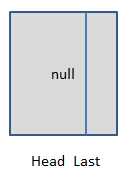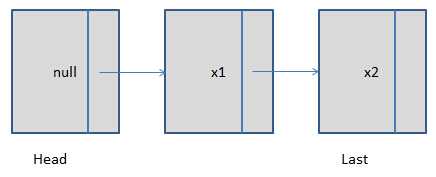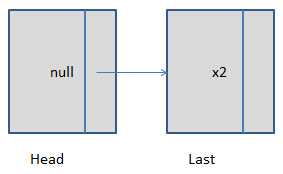标签:
1、对于LinkedBlockingQueue需要掌握以下几点
2、创建
Node节点内部类与LinkedBlockingQueue的一些属性

static class Node<E> { E item;//节点封装的数据 /** * One of: * - the real successor Node * - this Node, meaning the successor is head.next * - null, meaning there is no successor (this is the last node) */ Node<E> next;//下一个节点 Node(E x) { item = x; } } /** 指定链表容量 */ private final int capacity; /** 当前的元素个数 */ private final AtomicInteger count = new AtomicInteger(0); /** 链表头节点 */ private transient Node<E> head; /** 链表尾节点 */ private transient Node<E> last; /** 出队锁 */ private final ReentrantLock takeLock = new ReentrantLock(); /** 出队等待条件 */ private final Condition notEmpty = takeLock.newCondition(); /** 入队锁 */ private final ReentrantLock putLock = new ReentrantLock(); /** 入队等待条件 */ private final Condition notFull = putLock.newCondition();
2.1、public LinkedBlockingQueue(int capacity)
使用方法:
Queue<String> abq = new LinkedBlockingQueue<String>(1000);
源代码:

/** * 创建一个 LinkedBlockingQueue,容量为指定容量 */ public LinkedBlockingQueue(int capacity) { if (capacity <= 0) throw new IllegalArgumentException(); this.capacity = capacity; last = head = new Node<E>(null);//初始化头节点和尾节点,均为封装了null数据的节点 }
注意点:
2.2、public LinkedBlockingQueue()
使用方法:
Queue<String> abq = new LinkedBlockingQueue<String>();
源代码:

/** * 创建一个LinkedBlockingQueue,容量为整数最大值 */ public LinkedBlockingQueue() { this(Integer.MAX_VALUE); }
注意点:默认容量为整数最大值,可以看做没有容量限制
3、入队:
3.1、public boolean offer(E e)
原理:
使用方法:
源代码:

/** * 在队尾插入一个元素, * 容量没满,可以立即插入,返回true; * 队列满了,直接返回false * 注:如果使用了限制了容量的队列,这个方法比add()好,因为add()插入失败就会抛出异常 */ public boolean offer(E e) { if (e == null) throw new NullPointerException(); final AtomicInteger count = this.count;//获取队列中的元素个数 if (count.get() == capacity)//队列满了 return false; int c = -1; final ReentrantLock putLock = this.putLock; putLock.lock();//获取入队锁 try { if (count.get() < capacity) {//容量没满 enqueue(e);//入队 c = count.getAndIncrement();//容量+1 if (c + 1 < capacity)//如果上边+1后的容量再加1,还小于指定容量(说明在插入当前元素后,至少还可以再插一个元素) notFull.signal();//唤醒等待notFull条件的其中一个线程 } } finally { putLock.unlock();//释放入队锁 } if (c == 0)//如果c==0,这是什么情况? signalNotEmpty(); return c >= 0; }

/** * 创建一个节点,并加入链表尾部 * @param x */ private void enqueue(E x) { /* * 封装新节点,并赋给当前的最后一个节点的下一个节点,然后在将这个节点设为最后一个节点 */ last = last.next = new Node<E>(x); }

private void signalNotEmpty() { final ReentrantLock takeLock = this.takeLock; takeLock.lock();//获取出队锁 try { notEmpty.signal();//唤醒等待notEmpty条件的线程中的一个 } finally { takeLock.unlock();//释放出队锁 } }
如果,入队逻辑不懂,查看最后总结部分入队逻辑的图,代码非常简单,流程看注释即可,只有一点注意点:
3.2、public boolean offer(E e, long timeout, TimeUnit unit) throws InterruptedException
原理:
使用方法:

try { abq.offer("hello2",1000,TimeUnit.MILLISECONDS); } catch (InterruptedException e) { e.printStackTrace(); }
源代码:

/** * 在队尾插入一个元素,,如果队列已满,则进入等待,直到出现以下三种情况: * 1、被唤醒 * 2、等待时间超时 * 3、当前线程被中断 */ public boolean offer(E e, long timeout, TimeUnit unit) throws InterruptedException { if (e == null) throw new NullPointerException(); long nanos = unit.toNanos(timeout);// 转换为纳秒 int c = -1; final ReentrantLock putLock = this.putLock;// 入队锁 final AtomicInteger count = this.count;// 总数量 putLock.lockInterruptibly(); try { while (count.get() == capacity) {// 容量已满 if (nanos <= 0)// 已经超时 return false; /* * 进行等待: 在这个过程中可能发生三件事: * 1、被唤醒-->继续当前这个while循环 * 2、超时-->继续当前这个while循环 * 3、被中断-->抛出中断异常InterruptedException */ nanos = notFull.awaitNanos(nanos); } enqueue(e);// 入队 c = count.getAndIncrement();// 入队元素数量+1 if (c + 1 < capacity) notFull.signal(); } finally { putLock.unlock(); } if (c == 0) signalNotEmpty(); return true; }
注意:
3.3、public void put(E e) throws InterruptedException
原理:
使用方法:

try { abq.put("hello1"); } catch (InterruptedException e) { e.printStackTrace(); }
源代码:

/** * 在队尾插一个元素 * 如果队列满了,一直阻塞,直到队列不满了或者线程被中断 */ public void put(E e) throws InterruptedException { if (e == null) throw new NullPointerException(); int c = -1; final ReentrantLock putLock = this.putLock;//入队锁 final AtomicInteger count = this.count;//当前队列中的元素个数 putLock.lockInterruptibly();//加锁 try { while (count.get() == capacity) {//如果队列满了 /* * 加入notFull等待队列,直到队列元素不满了, * 被其他线程使用notFull.signal()唤醒 */ notFull.await(); } enqueue(e);//入队 c = count.getAndIncrement();//入队数量+1 if (c + 1 < capacity) notFull.signal(); } finally { putLock.unlock(); } if (c == 0) signalNotEmpty(); }
4、出队
4.1、public E poll()
原理:
使用方法:
abq.poll();
源代码:

/** * 出队: * 1、如果没有元素,直接返回null * 2、如果有元素,出队 */ public E poll() { final AtomicInteger count = this.count;//获取元素数量 if (count.get() == 0)//没有元素 return null; E x = null; int c = -1; final ReentrantLock takeLock = this.takeLock; takeLock.lock();//获取出队锁 try { if (count.get() > 0) {//有元素 x = dequeue();//出队 //元素个数-1(注意:该方法是一个无限循环,直到减1成功为止) c = count.getAndDecrement(); if (c > 1)//还有元素 notEmpty.signal();//唤醒等待在notEmpty队列中的其中一条线程 } } finally { takeLock.unlock();//释放出队锁 } if (c == capacity)//c == capacity是怎么发生的 signalNotFull(); return x; }

/** * 从队列头部移除一个节点 */ private E dequeue() { Node<E> h = head;//获取头节点:x==null Node<E> first = h.next;//将头节点的下一个节点赋值给first h.next = h; // 将当前将要出队的节点置null(为了使其做head节点做准备) head = first;//将当前将要出队的节点作为了头节点 E x = first.item;//获取出队节点的值 first.item = null;//将出队节点的值置空 return x; }

private void signalNotFull() { final ReentrantLock putLock = this.putLock; putLock.lock(); try { notFull.signal(); } finally { putLock.unlock(); } }
注意:出队逻辑如果不懂,查看最后总结部分的图
4.2、public E poll(long timeout, TimeUnit unit) throws InterruptedException
原理:
使用方法:

try { abq.poll(1000, TimeUnit.MILLISECONDS); } catch (InterruptedException e) { e.printStackTrace(); }
源代码:

/** * 从队列头部删除一个元素, * 如果队列不空,出队; * 如果队列已空,判断时间是否超时,如果已经超时,返回null * 如果队列已空且时间未超时,则进入等待,直到出现以下三种情况: * 1、被唤醒 * 2、等待时间超时 * 3、当前线程被中断 */ public E poll(long timeout, TimeUnit unit) throws InterruptedException { E x = null; int c = -1; long nanos = unit.toNanos(timeout); final AtomicInteger count = this.count; final ReentrantLock takeLock = this.takeLock; takeLock.lockInterruptibly(); try { while (count.get() == 0) {//如果队列没有元素 if (nanos <= 0)//已经超时 return null; /* * 进行等待: * 在这个过程中可能发生三件事: * 1、被唤醒-->继续当前这个while循环 * 2、超时-->继续当前这个while循环 * 3、被中断-->抛出异常 */ nanos = notEmpty.awaitNanos(nanos); } x = dequeue();//出队 c = count.getAndDecrement(); if (c > 1) notEmpty.signal(); } finally { takeLock.unlock(); } if (c == capacity) signalNotFull(); return x; }
4.3、public E take() throws InterruptedException
原理:
使用方法:

try { abq.take(); } catch (InterruptedException e) { e.printStackTrace(); }
源代码:

/** * 出队: * 如果队列空了,一直阻塞,直到队列不为空或者线程被中断 */ public E take() throws InterruptedException { E x; int c = -1; final AtomicInteger count = this.count;//获取队列中的元素总量 final ReentrantLock takeLock = this.takeLock; takeLock.lockInterruptibly();//获取出队锁 try { while (count.get() == 0) {//如果没有元素,一直阻塞 /* * 加入等待队列, 一直等待条件notEmpty(即被其他线程唤醒) * (唤醒其实就是,有线程将一个元素入队了,然后调用notEmpty.signal()唤醒其他等待这个条件的线程,同时队列也不空了) */ notEmpty.await(); } x = dequeue();//出队 c = count.getAndDecrement();//元素数量-1 if (c > 1) notEmpty.signal(); } finally { takeLock.unlock(); } if (c == capacity) signalNotFull(); return x; }
总结:
1、具体入队与出队的原理图:
图中每一个节点前半部分表示封装的数据x,后边的表示指向的下一个引用。
1.1、初始化

初始化之后,初始化一个数据为null,且head和last节点都是这个节点。
1.2、入队两个元素过后

这个可以根据入队方法enqueue(E x)来看,源代码再贴一遍:

/** * 创建一个节点,并加入链表尾部 * * @param x */ private void enqueue(E x) { /* * 封装新节点,并赋给当前的最后一个节点的下一个节点,然后在将这个节点设为最后一个节点 */ last = last.next = new Node<E>(x); }
其实这我们就可以发现其实真正意义上出队的头节点是Head节点的下一个节点。(这也就是Node这个内部类中对next的注释,我没有翻译)
1.3、出队一个元素后

表面上看,只是将头节点的next指针指向了要删除的x1.next,事实上这样我觉的就完全可以,但是jdk实际上是将原来的head节点删除了,而上边看到的这个head节点,正是刚刚出队的x1节点,只是其值被置空了。
这一块对应着源代码来看:dequeue()

/** * 从队列头部移除一个节点 */ private E dequeue() { Node<E> h = head;// 获取头节点:x==null Node<E> first = h.next;// 将头节点的下一个节点赋值给first h.next = h; // 将当前将要出队的节点置null(为了使其做head节点做准备) head = first;// 将当前将要出队的节点作为了头节点 E x = first.item;// 获取出队节点的值 first.item = null;// 将出队节点的值置空 return x; }
2、三种入队对比:
3、三种出队对比:
4、ArrayBlockingQueue与LinkedBlockingQueue对比
两个疑问:(望大神指点)
标签:
原文地址:http://www.cnblogs.com/java-zhao/p/5135958.html